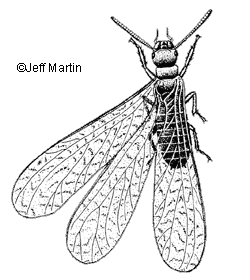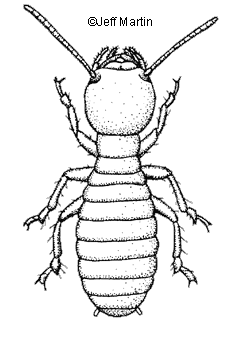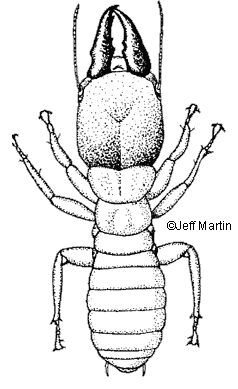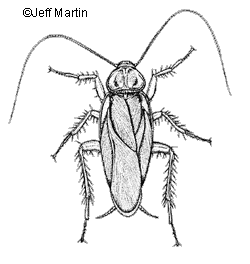Termites
Termites are morphologically uncomplicated insects, in contrast with their astonishingly complex social behavior. Superficially termites resemble and are sometimes mistaken for ants, which also exhibit social behavior. Sonoran Desert termites range in size from 4 to 11 mm (J - 7/16 inches) long, not including the wings of alates (the winged reproductive adult forms that appear occasionally, especially during and following rains). Workers are white with small head capsules. Soldiers have enlarged head capsules, and very formidable jaws, or in one of our species, a snout-like structure.
Distribution
There are over 40 species of termites in 10 genera widely distributed in the Sonoran Desert.
| Order: Isoptera |
| Suborder: Apocrita |
| Families: Kalotermitidae, Hodotermitidae, Rhinotermitidae, Termitidae |
| Sonoran Desert genera: |
|
| Spanish name: termitos |
Ecology
 |
This highly successful group of social insects plays an essential ecological role in the decomposition and recycling of a nutritionally poor, highly resistant, but extremely abundant substance: cellulose. Cellulose is a poly-saccharide, that is, a large number of sugar molecules linked together by tight chemical bonds to form a very long, strong chain. Cellulose is the substance that gives plants their structure and is the most abundant organic compound in the world. Wood is mostly cellulose, and so are cotton and all paper products. In the Sonoran Desert, trees, shrubs, grasses, and cactus skeletons are the primary source of cellulose, which represents more than half of all the organic material produced by photosynthesis. Cellulose is durable because it is a physically strong material resistant to mechanical breakdown, but more important, very few organisms produce enzymes that can chemically break it down. Among those that do produce the cellulose break-down enzyme cellulase are fungi and tiny animals called protozoans. Termites do not produce cellulase, but all termites contain protozoans in their guts in a mutually beneficial relationship known as mutualism. Termites grind up the cellulose mechanically by biting off bits and chewing them up; then the protozoans in their guts break down the chewed mass into sugars, which are readily absorbed through the termites’ guts. Both the termites and their protozoans share in the nutritional benefit of these released sugars. Newly hatched termites are first inoculated with these indispensable protozoans by eating the feces of their older brothers and sisters.
 |
The ecological importance of Sonoran Desert termites can best be understood by considering the following question: What would happen if we didn’t have termites in our desert? Well, because our aridity severely limits the abundance and distribution of wood decaying fungi, without termites, we would soon be neck deep in cellulose in the form of mesquite and palo verde wood, dead grasses, cactus skeletons and dung. Eventually, few living plants would be left to produce food for animals because there would be no space for new plant seedlings to establish and no nutrients to sustain their growth. All of the space would be taken up by dry, un-recycled cellulose litter, and all of the nutrients would be tied up in this material and thus unavailable for plants in the soil. Without plants fixing carbon-producing food, most animals would disappear. So, without termites, the whole desert ecosystem as we know it would simply collapse.
Our termites partition the desert’s cellulose into many ecological niches. For example, one drywood termite, Marginitermes hubbardi, feeds primarily on saguaro skeletons, and another very large primitive drywood termite, Pterotermes occidentis, is a specialist on palo verde wood. Gnathamitermes perplexus, the crust-building subterranean desert termite, feeds on grass, fine dry plant parts and the weathered outer surfaces of woody tissues of all kinds. Heterotermes aureus, the lowland subterranean termite, is an important consumer of native woods on the desert floor and also of pine.
Life History
 |
In the Sonoran Desert large, well-established termite colonies of many species produce nymphs in the late spring. When these nymphs shed their external skeletons for the last time, fully-formed functional wings unfold from the wing pads, and the resultant individuals are called alates. Alates are reproductively mature males and females ready and eager to start new colonies. They stay in the parent colony until conditions are optimal (usually during or after rain); then they leave the galleries of the colony, surrounded by soldier termites ready to defend their brothers and sisters against ants and other enemies as they depart. The alates then take flight.
The season and time of termite flights depend on the species, but alates from all colonies of a given species in an area fly simultaneously. Just how far alates fly is not known for any species, but it is assumed that the flights of reproductives serve to assure new colonization some distance from the home colony. The simultaneous flights also promote outbreeding by increasing the probability that reproductives from one colony will mate with members of other colonies.
Soon after winged termites alight, they shed their wings by breaking them off at lines of weakness (like perforations in paper) near the point of their attachment to the body. Females may then use a chemical odor called a pheromone to “call ”males. Males attracted to this substance may be accepted or rejected by the female. A rejected male is forced to try his luck elsewhere. The fortunate male who is accepted by a female is permitted to follow her on the ground as she runs quickly about looking for the ideal place to start a new colony. During this “tandem running” phase of courtship, the male remains within touching distance of the female until she finds the “perfect” place (in the ground or in dead wood, again depending on the species of termite) to begin a new colony. The pair then settles into a monogamous relationship and cooperative family rearing.
 |
After mating, the queen lays a few eggs that soon hatch into tiny termite larvae. These are fed and nurtured by both the mother and father until they are large enough to begin foraging for wood and other sources of cellulose, at which time the young termites take over the work of feeding the larvae that have hatched from a second set of eggs. When the parents feed their first batch of offspring, the protozoans required to produce the enzyme needed for cellulose digestion are transferred from the mother’s and father’s stomachs to the larvae, and this protozoan inoculum is all that is required to get a culture going in the offspring so that they too, with the aid of the microbes, can digest their own cellulose.
Social Behavior
Termites can accurately be described as “tiny social cockroaches” because they evolved from a common ancestor with wood-dwelling cockroaches, to whom they are very closely related. They first appeared on earth during the age of the dinosaurs, about 100 million years ago. Termites are social in ways not unfamiliar to humans. We live together with others of our kind in complex societies, we divide the many tasks needed to support our communities and we care for our young long after they are born. Termites likewise live in complex societies, have division of labor, and care for their young.
 |
A well-established termite society or colony minimally consists of a king and queen, which are responsible for producing offspring: soldiers, which defend the colony against its enemies; and workers, which collect and process wood or other sources of cellulose and feed the royal couple and the soldiers, which are unable to feed themselves. Workers also care for eggs produced by the queen, and they tend to the young termite larvae that hatch from these eggs. The categories of king, queen, soldiers, and workers in a termite colony are referred to as castes. All of these are wingless; however, after a termite colony reaches a certain size (a few dozen to several thousand individuals, depending on the species), the colony begins to produce nymphs. These nymphs have small pads on their backs that contain developing wings. Regulation of the development of different castes in a termite colony is controlled by chemicals in the colony that are transferred from individual to individual by social feeding called tropholaxis. Exactly how different developmental trajectories are regulated in termite colonies remains an entomological mystery.
Knee Deep in Dung
Termites eat dead plant material and herbivore dung, thereby removing
this litter from the surface of the land, permitting sunlight and moisture
to reach new growth. On its own, dry cow dung decomposes very slowly.
Research conducted in southwestern deserts and desert grasslands by New
Mexico State University’s Walt Whitford estimates that without the action
of termites, cow pies would smother the land, covering 20 percent of the
surface in 50 years.![]()










